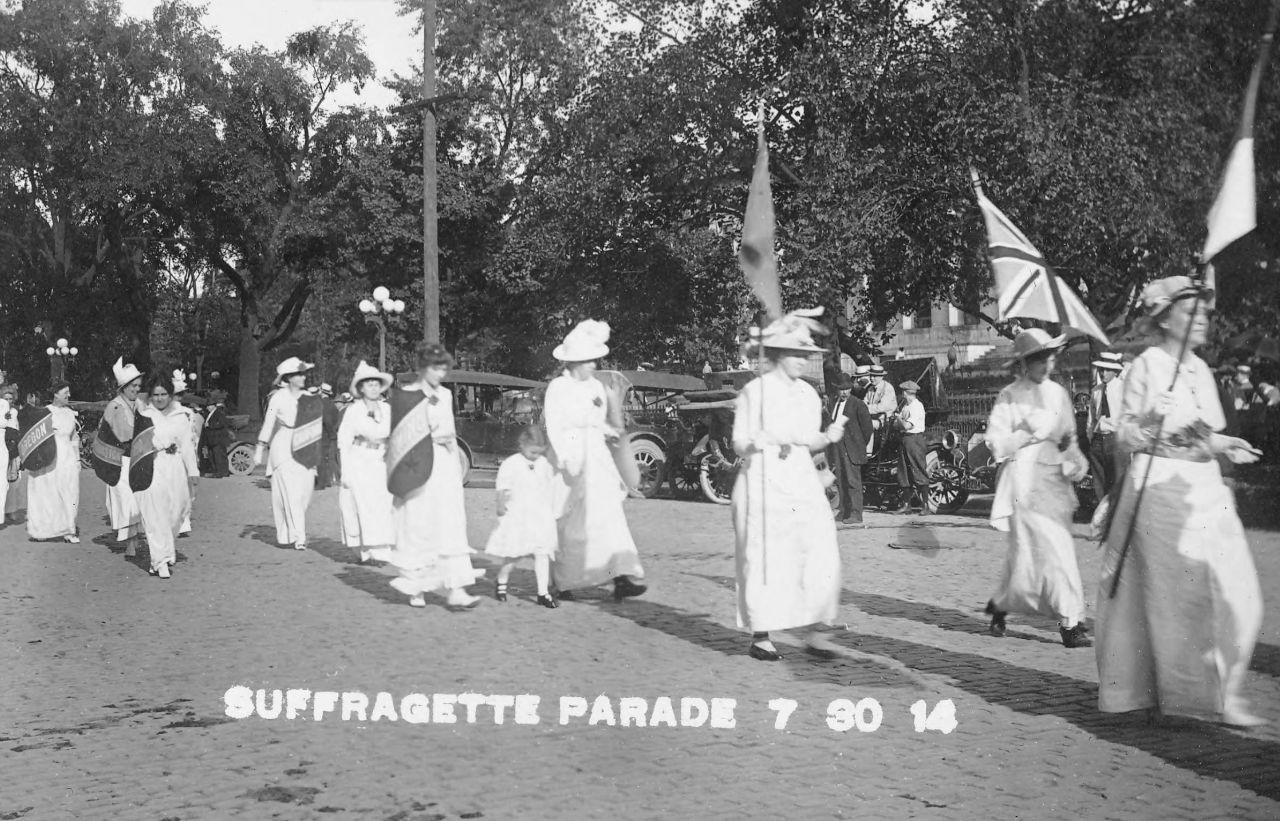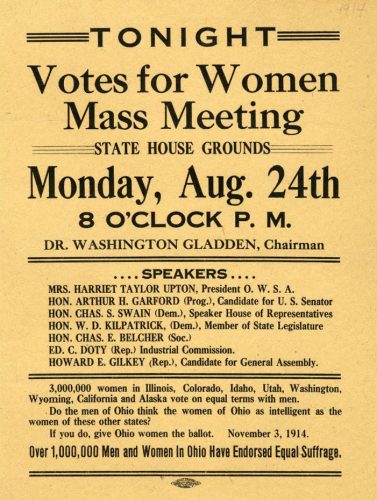Women’s Voices, Women’s Votes: Suffrage History on Ohio Memory

2020 is a year of many anniversaries, some of which you have heard (and will continue to hear) about on the Ohio Memory blog throughout this year. One major milestone with a centennial taking place this year is the ratification of the 19th Amendment to the United States Constitution, which enshrined in the supreme law of the land the right of all citizens to vote, regardless of sex.

The language of the amendment is simple: “The right of citizens of the United States to vote shall not be denied or abridged by the United States or by any State on account of sex.” But the story it tells is far more complex, and as we commemorate 100 years of women’s suffrage in this country, we have the opportunity to reflect on the both the tremendous success that the amendment represented, as well as the shortfalls and struggles that have characterized the right to vote for Americans up through today.
The passage of the 19th Amendment was decades in the making. When it was first introduced to Congress in 1878, American women had already been pushing for universal suffrage for many years, building upon their political activism in other major movements like abolition and temperance. In the intervening years, as suffrage proponents worked for nationwide legislation, they continued efforts in parallel at the local and state level, with varying degrees of success (learn more about work in Ohio by the Franklin County Woman Suffrage Association in a blog post from last year). Finally, the amendment was passed by Congress early in the summer of 1919. From there, it moved to the states for ratification, with Ohio among the first on June 16, 1919. With approval from Tennessee on August 18, 1920, the 19th Amendment reached the required threshold, and became law on August 26, 1920.
In the years following this watershed moment, it’s critical to note that suffrage wasn’t nearly as universal as we might think. In particular, people of color, and women especially, remained largely disenfranchised until the passing of additional legislation through the 20th century. The 1924 Native American Citizen Act granted rights of citizenship to American Indians, though they continued to combat state-level policies until 1957; the Immigration and Nationality Act changed immigration laws for Asian Americans in 1952, finally allowing for full citizenship. Racially-motivated limitations in the form of poll taxes and literacy tests, along with physical and political intimidation, kept many from voting, including African Americans in the South and members of the Latinx community, until the Voting Rights Act of 1965 and later extensions in 1975. Still today, a variety of issues at the ballot box continue to limit the ability of Americans to take full advantage of their constitutional right.

Ohio Memory provides us with a wide range of historical materials related to the fight for suffrage, and examples of Ohioans using their voice even outside the framework of the vote. On the blog, we’ve provided examples of some of these stories over the years, like Victoria Woodhull and her historic presidential run, and the 4th National Women’s Rights Convention, held in Cleveland in October 1853. Among the history documented on Ohio Memory, you can explore:
- the work of the League of Women Voters of Tiffin from the Seneca County Digital Library
- the papers from Kent State University of Betsy Mix Cowles, a prominent abolition and suffrage activist who helped put on the 1850 Ohio Women’s Convention in Salem, just two years after the historic Seneca Falls Convention
- efforts of the League of Women Voters of Ohio, including contribution to a National Honor Roll list honoring suffragists for their work during the movement and their later work in politics
- the collection of Frances Casement, including correspondence with Susan B. Anthony, covering Casement’s involvement in the Ohio Woman Suffrage Association (and as its president from 1885 to 1888)
- a “Get Out the Vote” campaign by the Ohio NAACP in 1968, emphasizing the importance of voting among African Americans
- petitions in support of suffrage from Ohioans across the state
- and much more!
This Saturday, March 14th, the Ohio History Connection will kick off upcoming commemoration efforts with 100 Years of Women’s Activism [Editor’s Note: this event has been postponed, with its new date to be determined]. If you can’t make it to the Ohio History Center, check out the Ohio Women’s Suffrage Centennial and the Women’s Vote Centennial for more about events around the state, follow the Ohio Women’s Activism blog series from the Ohio History Connection, and take time to explore more of the many stories told on Ohio Memory.
Thank you to Lily Birkhimer, Digital Projects Coordinator at the Ohio History Connection, for this week’s post!
Ohio Memory is celebrating 20 years! Visit our blog all year long to learn more about our program, partners and collections.



Leave a Reply
You must be logged in to post a comment.